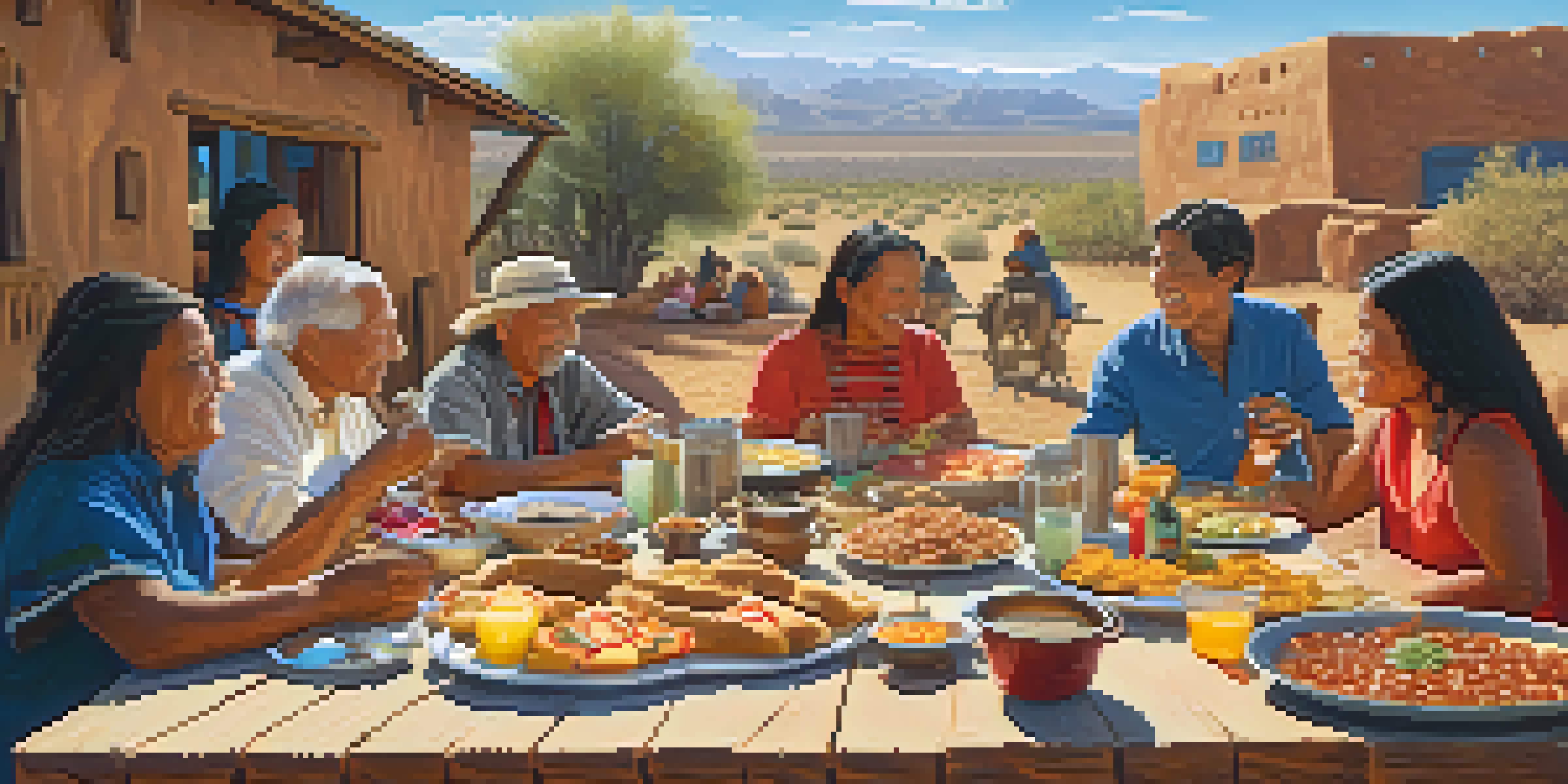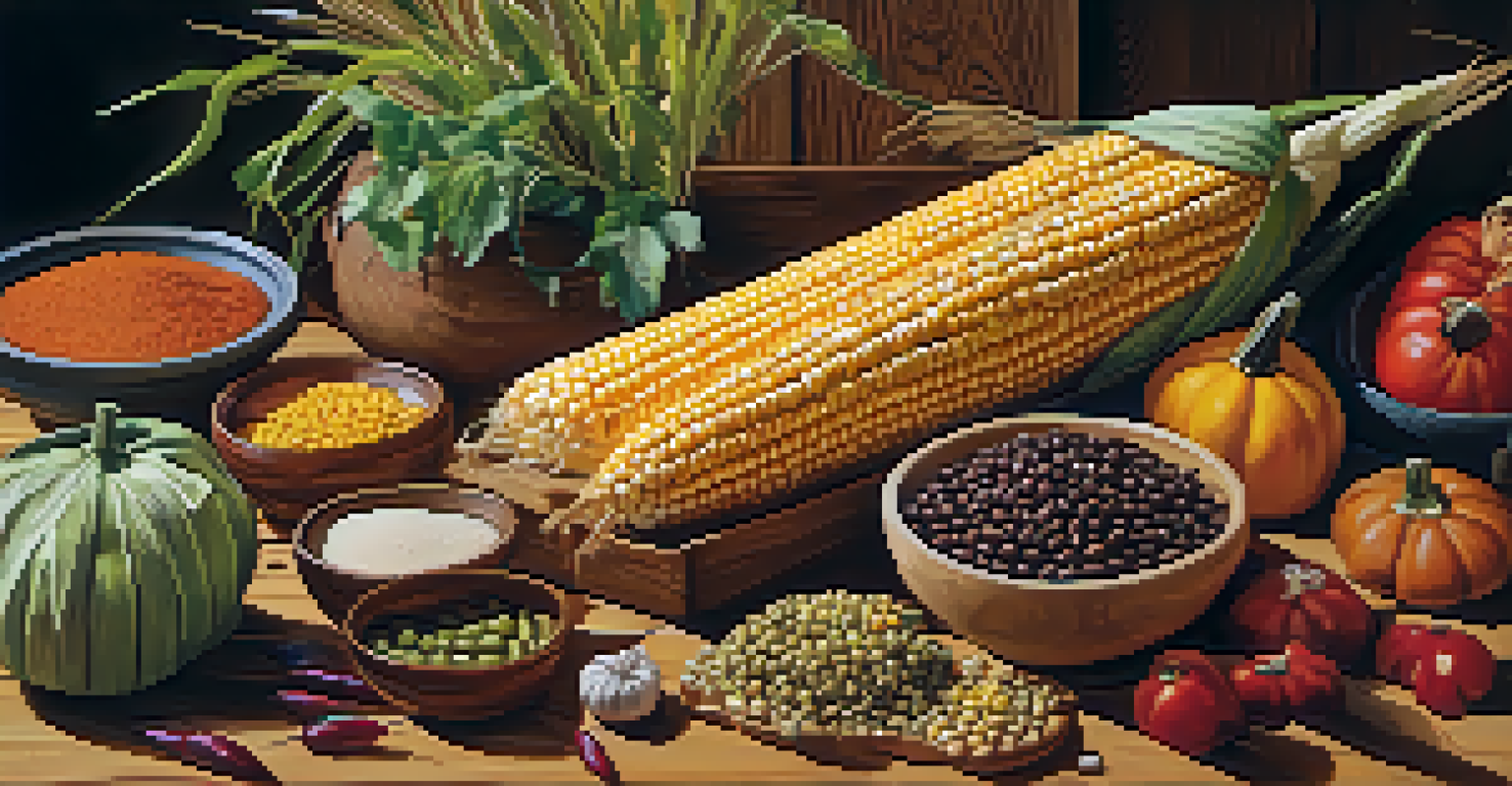Exploring Native American Cuisine: A Taste of Arizona's Heritage

Introduction to Native American Cuisine in Arizona
Arizona's Native American cuisine is a vibrant tapestry woven from rich traditions and diverse ingredients. It reflects the deep connection between the land and its people, showcasing flavors that have been passed down through generations. From the Navajo to the Hopi, each tribe brings its own unique culinary contributions, making Arizona a culinary treasure trove.
Food is the ingredient that binds us together.
The ingredients used in these dishes often come from the local environment, highlighting the significance of sustainability and respect for nature. Corn, beans, and squash, known as the 'Three Sisters,' serve as staples in many Native American diets, symbolizing nourishment and balance. This harmonious relationship with the land plays a crucial role in the preparation of traditional dishes.
As we embark on this journey to explore Native American cuisine in Arizona, we'll uncover not just recipes but also the stories and cultural significance behind the food. Each dish tells a story of resilience, heritage, and community, inviting us to appreciate the flavors and history that shape this unique culinary landscape.
The Importance of Ingredients in Native American Cooking
Ingredients are the heart and soul of Native American cooking, where each component serves a purpose beyond mere flavor. Staples like corn, which has been cultivated for thousands of years, are not just food; they are a cultural symbol representing life and sustenance. The careful selection of ingredients reflects a deep understanding of the land and its offerings.

In addition to corn, other native ingredients like wild game, cactus, and various herbs play a crucial role in traditional dishes. For example, prickly pear cactus is often used in jams and jellies, while mesquite flour is a nutritious alternative to wheat flour, adding a unique flavor profile to baked goods. The use of local herbs enhances the dishes, showcasing the natural bounty of the region.
Cultural Heritage in Every Bite
Native American cuisine in Arizona reflects rich traditions and stories that connect the food to the land and its people.
This emphasis on fresh, local ingredients promotes a farm-to-table approach long before it became a trend in modern cuisine. By honoring the land and its resources, Native American cooking encourages a sustainable lifestyle and a deeper appreciation for the environment.
Traditional Dishes from the Navajo Nation
The Navajo Nation boasts a rich culinary heritage, with traditional dishes that reflect their deep-rooted history. One iconic dish is frybread, a fluffy, golden bread that has become a symbol of Native American resilience. It's often served with savory toppings like ground beef, beans, or even sweetened with honey, making it a versatile staple.
Cooking is like love; it should be entered into with abandon or not at all.
Another beloved dish is Navajo tacos, which feature frybread topped with a variety of ingredients, from lettuce and cheese to chili and salsa. This fusion of flavors represents the blending of traditional and modern culinary practices, creating a dish that is both comforting and satisfying. It's not just food; it's a gathering point for family and community.
Navajo cuisine also emphasizes the importance of seasonal ingredients, with dishes changing throughout the year to reflect what is available. This adaptability showcases the tribe's resourcefulness and respect for the land, ensuring that their culinary traditions continue to thrive in a modern world.
Exploring Hopi Corn and Its Cultural Significance
Hopi corn is a staple that holds immense cultural significance for the Hopi people, representing their agricultural heritage and spirituality. Unlike many commercially grown varieties, Hopi corn comes in vibrant colors, such as blue, red, and yellow, each symbolizing different aspects of life and nature. The cultivation of this corn is deeply intertwined with their ancestral practices and rituals.
The Hopi people celebrate the planting and harvesting of corn through ceremonial dances and festivals, emphasizing the importance of gratitude and respect for the earth. Corn is not just food; it is a sacred element that nourishes both body and soul. The Hopi believe that by honoring their crops, they maintain a spiritual balance with the universe.
Sustainability and Local Ingredients
Traditional dishes emphasize the use of local, sustainable ingredients like corn, beans, and wild game, honoring the relationship with nature.
In the kitchen, Hopi corn is transformed into various traditional dishes, such as posole and cornmeal mush. These preparations not only showcase the versatility of the grain but also serve as a reminder of the Hopi's connection to their land and heritage. Each bite of Hopi corn is steeped in history and tradition, making it a true taste of their culture.
The Role of Gatherings and Community in Native American Cuisine
Gatherings and community play a pivotal role in Native American cuisine, emphasizing the importance of sharing food as a way to strengthen bonds. Traditional meals are often enjoyed during communal feasts, where families and friends come together to celebrate life and heritage. Food becomes a medium for storytelling, connecting the past with the present.
During these gatherings, dishes are prepared with love and care, often passed down through generations. Recipes are not just instructions; they carry stories and memories, creating a rich tapestry of cultural identity. The act of cooking and sharing food fosters a sense of belonging and pride within the community.
These gatherings also serve as an opportunity to teach younger generations about their culinary heritage. By involving children and youth in the cooking process, they learn the significance of traditional dishes and the values associated with them. This intergenerational exchange keeps the culinary traditions alive and vibrant for future generations.
Modern Influences on Native American Cuisine
As the world evolves, so does Native American cuisine, with modern influences shaping traditional practices. Chefs and home cooks alike are experimenting with new flavors and techniques while honoring their roots. This fusion of old and new creates exciting culinary experiences that attract both locals and visitors.
For example, contemporary Native American chefs are incorporating global ingredients into traditional recipes, infusing them with a fresh perspective. This innovative approach not only broadens the appeal of Native American cuisine but also showcases the adaptability of these culinary traditions in a modern context.
Community and Culinary Traditions
Gatherings and communal meals play a vital role in preserving culinary heritage, fostering connections, and passing down recipes through generations.
Despite these changes, the essence of Native American cuisine remains intact. The focus on community, sustainability, and respect for the land continues to guide culinary practices, ensuring that the heart of Native American cooking beats strong in today's diverse culinary landscape.
Conclusion: A Culinary Journey Worth Exploring
Exploring Native American cuisine in Arizona is more than just a culinary adventure; it is a journey into the heart of a rich cultural heritage. The flavors, traditions, and stories behind each dish provide a deeper understanding of the communities that have thrived in this region for centuries. Every meal is an invitation to connect with history and the land.
As we savor the diverse dishes from various tribes, it's essential to appreciate the significance of these culinary practices. Each bite offers a glimpse into the values of sustainability, community, and respect for nature that are central to Native American culture. By embracing these flavors, we honor the traditions of the past while celebrating the vibrant present.

So, whether you're enjoying a plate of frybread, savoring Hopi corn, or participating in a communal feast, remember that you are partaking in a culinary legacy that transcends time. Native American cuisine invites us to explore, learn, and connect, making it a delicious journey worth taking.